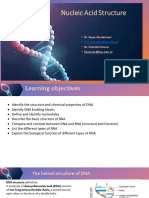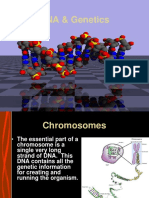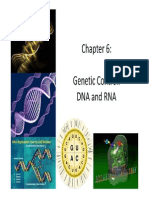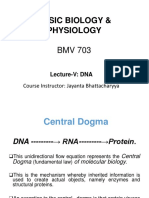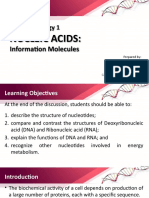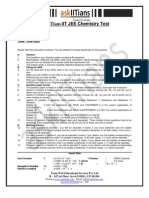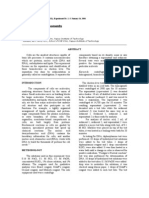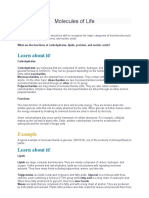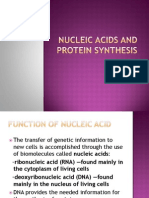0 ratings0% found this document useful (0 votes)
59 viewsBIO 111 Lecture 8-Nucleic Acids
BIO 111 Lecture 8-Nucleic Acids
Uploaded by
ChinyamaThe document discusses nucleic acids and their components. There are two main types of nucleic acids: DNA and RNA. DNA is found in the cell nucleus and contains the genetic code. RNA is found throughout the cell and helps synthesize proteins. Both DNA and RNA are made up of nucleotides, which consist of a nitrogenous base, a pentose sugar, and a phosphate group. Nucleotides combine to form polynucleotide chains. DNA exists as a double helix held together by base pairing, while RNA is generally single-stranded. There are three main types of RNA: mRNA, tRNA, and rRNA, which help in protein synthesis.
Copyright:
© All Rights Reserved
Available Formats
Download as PPT, PDF, TXT or read online from Scribd
BIO 111 Lecture 8-Nucleic Acids
BIO 111 Lecture 8-Nucleic Acids
Uploaded by
Chinyama0 ratings0% found this document useful (0 votes)
59 views47 pagesThe document discusses nucleic acids and their components. There are two main types of nucleic acids: DNA and RNA. DNA is found in the cell nucleus and contains the genetic code. RNA is found throughout the cell and helps synthesize proteins. Both DNA and RNA are made up of nucleotides, which consist of a nitrogenous base, a pentose sugar, and a phosphate group. Nucleotides combine to form polynucleotide chains. DNA exists as a double helix held together by base pairing, while RNA is generally single-stranded. There are three main types of RNA: mRNA, tRNA, and rRNA, which help in protein synthesis.
Original Title
BIO 111 Lecture 8-Nucleic Acids.ppt
Copyright
© © All Rights Reserved
Available Formats
PPT, PDF, TXT or read online from Scribd
Share this document
Did you find this document useful?
Is this content inappropriate?
The document discusses nucleic acids and their components. There are two main types of nucleic acids: DNA and RNA. DNA is found in the cell nucleus and contains the genetic code. RNA is found throughout the cell and helps synthesize proteins. Both DNA and RNA are made up of nucleotides, which consist of a nitrogenous base, a pentose sugar, and a phosphate group. Nucleotides combine to form polynucleotide chains. DNA exists as a double helix held together by base pairing, while RNA is generally single-stranded. There are three main types of RNA: mRNA, tRNA, and rRNA, which help in protein synthesis.
Copyright:
© All Rights Reserved
Available Formats
Download as PPT, PDF, TXT or read online from Scribd
Download as ppt, pdf, or txt
0 ratings0% found this document useful (0 votes)
59 views47 pagesBIO 111 Lecture 8-Nucleic Acids
BIO 111 Lecture 8-Nucleic Acids
Uploaded by
ChinyamaThe document discusses nucleic acids and their components. There are two main types of nucleic acids: DNA and RNA. DNA is found in the cell nucleus and contains the genetic code. RNA is found throughout the cell and helps synthesize proteins. Both DNA and RNA are made up of nucleotides, which consist of a nitrogenous base, a pentose sugar, and a phosphate group. Nucleotides combine to form polynucleotide chains. DNA exists as a double helix held together by base pairing, while RNA is generally single-stranded. There are three main types of RNA: mRNA, tRNA, and rRNA, which help in protein synthesis.
Copyright:
© All Rights Reserved
Available Formats
Download as PPT, PDF, TXT or read online from Scribd
Download as ppt, pdf, or txt
You are on page 1of 47
BIOMOLECULES AND
CELLS: BIO 111
Mr. Derrick Banda MSc, BSc
NUCLEIC ACIDS
Introduction
• A nucleic acid is a polymer in which the monomer
units are called nucleotides.
There are two Types of Nucleic Acids:
• DNA: Deoxyribonucleic Acid: Found within cell
nucleus, used for storing and transferring of genetic
information that are passed from one cell to another
during cell division.
• RNA: Ribonucleic Acid: Occurs in all parts of cell
serving the primary function of synthesizing the
proteins needed for cell functions.
Introduction
• Nucleic acid carry hereditary (genetic) material which
determine the characteristic of living organisms such as
height, skin complexion, eye colour etc.
• The double-helix DNA contains the genetic information
necessary to guide synthesis of all the proteins in a cell and
thus allow the continuity of life.
• The genetic information in a DNA is written in a triplet code
(sequence of three bases).
• These three letter codes of nucleotides (AUG, AAA, etc.) are
called codons.
• Individual codons represent specific amino acids.
Introduction
• The DNA Double Helix. DNA consists of two α-
helical polynucleotide strands intertwined to form a
double helix.
• RNA Polynucleotides. RNA molecules are single
stranded and there are several different types including;
1. Messenger RNA (mRNA)
2. Transfer RNA (tRNA)
3. Ribosomal RNA (rRNA)
• All RNAs participate in the assemblage of amino
acids to form different types of proteins
Components of a Nucleotide
• DNA and RNA are made up of building units
(monomers) known as nucleotide.
• Nucleotide then combine to form a long chain called
polynucleotide.
• DNA monomers are called deoxyribonucleotides,
and RNA monomers are called ribonucleotides.
• Both types of nucleotides contain;
1.Nitrogenous base
2.Five-carbon (Pentose) sugar molecule
3.Phosphate group
Components of a Nucleotide
1. NITROGEN BASE
• Two (2) types of Nitrogenous bases in nucleotides.
1. Purines, they are large, double-ring molecules
2. Pyrimidines, are smaller, single-ring molecules.
• Pyrimidines include cytosine (C, in both DNA and
RNA), thymine (T, in DNA only), and uracil (U, in
RNA only). Purines are adenine (A) and guanine(G).
2 . PENTOSE SUGARS
• There are two types of pentose sugars which make up a
nucleotide: Ribose in RNA. Deoxyribose in DNA
• RNA molecules contain ribose sugars in which the number
2 carbon is bonded to a hydroxyl group. In DNA, this
hydroxyl group is replaced by a hydrogen atom.
3. PHOSPHATE GROUP
• A phosphate group (PO42-) gives the nucleotide its
acidic characteristic.
Components of Nucleic Acids
Formation of a nucleotide and nucleoside
• The portion of the nucleotide containing just the
sugar and nitrogenous base is called a nucleoside.
Formation of a nucleotide and nucleoside
• A combination of a pentose sugar with one of
the four bases is called a nucleoside.
• The pentose sugar is linked to a nitrogenous
base through a beta glycosidic bond and
involves removal of water.
• A phosphate group is joined to the
nucleoside through a phospodiester bond to
form a nucleotide.
NUCLEOTIDE
• Nucleotide subunit of a nucleic acid contains a
phosphate group, a sugar component, and a
nitrogenous base.
• The base is attached to carbon 1’ of the pentose sugar
and phosphate is attached to carbon 5’.
Formation of Polynucleotide
Primary Nucleic Acid Structure
• DNA and RNA are made up of building units
(monomers) known as nucleotide.
• Repeated combination (condensation) of nucleotide
molecules leads to formation of long chain called
polynucleotide.
• In polynucleotides, nucleotides are joined to one
another by covalent bonds between the phosphate
of one nucleotide and the sugar of another. These
linkages are called phosphodiester linkages.
Formation of Phosphodiester linkage
• The 5′ carbon phosphate of an incoming
nucleotide attaches to the 3′ carbon hydroxyl of a
pentose sugar on a growing chain to form a 3’-5’
phosphodiester linkage (bridge).
Sugar phosphate backbone
• Phosphodiester linkages form the sugar-phosphate
backbone of both DNA and RNA.
Sugar phosphate backbone
• The nucleotide bases are on the interior of the two
strands, with a sugar-phosphate backbone on the
outside:
Example of a polynucleotide in DNA
• In DNA, A, C, G, and T are linked by 3’-5’ ester
bonds between deoxyribose and phosphate.
Reading a polynucleotide Structure
• A nucleic acid polymer has a
free 5’-phosphate group at
one end and a free 3’-OH
group at the other end
• The sequence is read from the
free 5’-end using the letters of
the bases
• This example reads
5’—A—C—G—T—3’
Polynucleotides of RNA and DNA
The DNA Double Helix
• In 1953 James Watson and his British colleague
Francis Crick discovered the double helix
structure of DNA.
• For this fundamental finding James, Francis and
Maurice Wilkins were awarded the Nobel Prize
for Physiology or Medicine in 1962.
The DNA Double Helix
• DNA is a double helix made up of two antiparallel
(the two strands run in opposite directions)
polynucleotide chains.
• The two chains are joined by hydrogen bonds
between the nucleotide bases, which pair
specifically:
Adenine (A) pairs with thymine (T) by forming two
hydrogen bonds.
Guanine (G) pairs with cytosine (C) by forming three
hydrogen bonds.
The DNA Double Helix
The base-pairing rules are rigid in Nucleic acids;
• Adenine can pair only with thymine, and
• Cytosine can pair only with guanine in DNA.
Anti-parallel orientation of a DNA duplex,
phosphodiester backbone, and base pairing
The DNA Double Helix
Structure of the DNA double strands
• DNA (deoxyribonucleic acid) is a double-stranded
molecule that is twisted into a helix like a spiral staircase.
• The hydrogen bonds hold the two chains together as a
duplex.
The two DNA strands are complementary
Chargaff’s rule
• In almost all DNA, the following rule holds:
The amount of adenine equals the amount of
thymine (A = T), and the amount of guanine
equals the amount of cytosine (G = C).
• As a result, the total abundance of purines
(A + G) equals the total abundance of
pyrimidines (T + C).
The DNA Double Helix
The base-pairing rules are rigid in Nucleic acids;
• Adenine can pair only with thymine, and
• Cytosine can pair only with guanine in DNA.
The two DNA strands are complementary
• A G in one strand will always be paired with a C in
the other. Similarly an A will always pair with a T.
• The DNA stores genetic information that can either be
copied (replicated) or transcribed into RNA. RNA
can then be translated into protein.
• In 1958, Francis Crick described this process as “the
central dogma of molecular biology.”
The RNA
• RNA is generally single-stranded molecule.
• RNA (ribonucleic acid) is a key intermediary between
a DNA sequence and a polypeptide (Protein).
• RNA has a chemical structure similar to that of DNA,
but there are two major differences.
1. The sugar in RNA is ribose instead of deoxyribose.
2. RNA contains the two purine bases adenine and
guanine and the pyrimidine cytosine, the fourth base
is different. The pyrimidine bases uracil (U) replaces
thymine.
The Chemical structure of RNA
• The RNA is a single stranded molecule, which uses
ribose as the sugar in its sugar-phosphate backbone,
and utilizes uracil in place of thymine.
Types of RNA
• RNAs are more varied than their DNA cousin.
• Created by copying regions of DNA, cellular RNAs
are synthesized as single strands, but they often
have self-complementary regions leading to
“foldbacks” containing duplex regions.
• The foldbacks are most easily visualized in the
ribosomal RNAs (rRNAs) and transfer RNAs
(tRNAs)
Types of RNA
There are three main types of RNA;
1.Messenger (mRNA)
2.Transfer RNA (tRNA)
3.Ribosomal RNA (rRNA)
Hydrogen Bonding in RNA
• Single-stranded RNA folds itself, hydrogen bonds
between complementary sequences stabilizes it
into three-dimensional shapes with complicated
surface characteristics.
1. Messenger (mRNA)
• mRNA carries a copy of a gene sequence in DNA
to the site of protein synthesis at the ribosome.
• mRNA Consist of a single strand of polynucleotide
chain.
Codons
• mRNA is read in set of three bases known as
Codons.
• Each codon codes for a single amino acid.
2. Transfer RNA (tRNA)
• Transfer RNA are single polynucleotide molecule
that act as temporary carrier of amino acids,
bringing the appropriate amino acids to the
ribosomes based on the messenger RNA
nucleotide sequence.
Structure of Transfer RNA
• RNA polynucleotide forms a twisted helix with parallel
nucleotide base sequence pairing up and attached by
hydrogen bonds.
• In tRNA, bases that do not to form base pairs create
three loops; D loop, anticodon loop and T loop.
• The tRNA has four arms of nucleotide base
sequence. (The Anticondon arm, acceptor arm,
DHU arm and T arm)
The four arms tRNA
Base pairing on RNA molecules (both
mRNA and tRNA) is;
• Adenine (A) pairing with Uracil (U)
• Guanine (G) pairs with Cytocine (C)
3. Ribosomal RNA (rRNA)
• Ribosomal RNA (rRNA) is the major constituent of
ribosome on which the mRNA binds.
• Ribosomal RNA (rRNA) catalyzes peptide bond
formation and provides a structural framework for
the ribosome.
• The transcribed message carried by the mRNA is
translated on the ribosome by rRNA to protein.
Ribosomal rRNA is made up of two subunits
• A large 60S subunit and a small 40S subunit for
Eukaryotic cells, while large 50S subunit and a
small 30S subunit for prokaryotic cells.
• These subunit stay apart but when translation begins
they come together.
END OF LECTURE!
THANK YOU.
You might also like
- Basics of Molecular BiologyDocument69 pagesBasics of Molecular BiologyYasin Putra Esbeye100% (2)
- Nucleic Acid StructureDocument22 pagesNucleic Acid StructureAmalNo ratings yet
- Nucleic AcidDocument48 pagesNucleic AcidsompurahardiNo ratings yet
- NucleotidesDocument49 pagesNucleotidesBikash SahNo ratings yet
- HBB 2116 Nucleotide DNA Biomolecule 8Document27 pagesHBB 2116 Nucleotide DNA Biomolecule 8Nickson OnchokaNo ratings yet
- Lecture 5. Nucleic Acids 1Document30 pagesLecture 5. Nucleic Acids 1chindikachantelleNo ratings yet
- LEC 5- NUCLEIC ACIDSDocument30 pagesLEC 5- NUCLEIC ACIDSnjongejeffreyNo ratings yet
- 3 Nucleic AcidDocument27 pages3 Nucleic Acidsyaharatabita28No ratings yet
- 2024 MYP 4 DNA-The Building Block of Life.Document157 pages2024 MYP 4 DNA-The Building Block of Life.aseda.stanhopeessamuahp6No ratings yet
- The Nucleic AcidsDocument94 pagesThe Nucleic Acidsmeklit birhanuNo ratings yet
- 4 - Chapter 4 Nucleic AcidsDocument31 pages4 - Chapter 4 Nucleic Acidsعزوز الشمريNo ratings yet
- Nucleic Acid: Structure & FunctionsDocument51 pagesNucleic Acid: Structure & FunctionsManahil SardarNo ratings yet
- Nucleicacids 200425083549Document49 pagesNucleicacids 200425083549nienminhNo ratings yet
- Nucleic AcidsDocument58 pagesNucleic AcidsLarahjane LeccionesNo ratings yet
- Dna Protein Synthesis 2015Document25 pagesDna Protein Synthesis 2015James ReiterNo ratings yet
- F1 - Genetic ControlDocument91 pagesF1 - Genetic Controlchoon lee minNo ratings yet
- Chapter 8. Nucleotides and Nucleic AcidsDocument33 pagesChapter 8. Nucleotides and Nucleic AcidsSofeaNo ratings yet
- 5-A1.2 Nucleıc AcidsDocument41 pages5-A1.2 Nucleıc Acidsmakaya02No ratings yet
- 1.5 Nucleic AcidsDocument23 pages1.5 Nucleic AcidsMûhd AïZām ÄhmâdNo ratings yet
- Module 8 - Nucleic Acids and Central DogmaDocument52 pagesModule 8 - Nucleic Acids and Central DogmaPauline Grace CadusaleNo ratings yet
- 3 - Structure of DNA, RNA, GenesDocument206 pages3 - Structure of DNA, RNA, GenesJustina VillageNo ratings yet
- Genetic Control of ProteinDocument43 pagesGenetic Control of ProteinGabriela ZahiuNo ratings yet
- Basic Biology and Physiology-Lecture 5 - DNADocument26 pagesBasic Biology and Physiology-Lecture 5 - DNARajdeep PawarNo ratings yet
- BCH 202 Chem of Nucleic Acid 20-21Document33 pagesBCH 202 Chem of Nucleic Acid 20-21yahayaabdullahiabubakar216No ratings yet
- Nucleic Acids and Protein SynthesisDocument9 pagesNucleic Acids and Protein Synthesis5kdpdc45bhNo ratings yet
- Nucleic AcidsDocument20 pagesNucleic AcidsraphaelongodiaNo ratings yet
- Biomolecules - Nucleic AcidsDocument12 pagesBiomolecules - Nucleic AcidsRyan S. CutamoraNo ratings yet
- Carry Instructions Be Copied Polynucleotides Nucleotides: Adenine Guanine Thymine Uracil CytosineDocument3 pagesCarry Instructions Be Copied Polynucleotides Nucleotides: Adenine Guanine Thymine Uracil Cytosineapi-296833859No ratings yet
- Made By: Mayar Mohamed: Facilitation CommitteeDocument10 pagesMade By: Mayar Mohamed: Facilitation Committeekareemtamer4040No ratings yet
- Nucleic AcidDocument50 pagesNucleic AcidPeralta, Mary Elaine G.No ratings yet
- 3 5 1 Heredity and Inheritance (DNA RNA)Document17 pages3 5 1 Heredity and Inheritance (DNA RNA)6ix9ine SoulNo ratings yet
- Dna & RnaDocument64 pagesDna & Rnagideon.cavidaNo ratings yet
- Sintesis Protein TA 2023-2024Document111 pagesSintesis Protein TA 2023-2024fdla rhmahNo ratings yet
- Lecture 3 DNA RNA Gen Structure Ade FKUI 2012Document44 pagesLecture 3 DNA RNA Gen Structure Ade FKUI 2012Faridah Yuwono 28No ratings yet
- Dna and Rna StructureDocument26 pagesDna and Rna StructureVince Lenzer BeliganioNo ratings yet
- Basics of Molecular BiologyDocument69 pagesBasics of Molecular BiologypathinfoNo ratings yet
- Biochemistry - Nucleic AcidsDocument30 pagesBiochemistry - Nucleic AcidsBalakrishnan Rengesh100% (2)
- VPB 112 Biochem - 1Document10 pagesVPB 112 Biochem - 1malliksonali20No ratings yet
- 20 Nucleic Acids BICHDocument30 pages20 Nucleic Acids BICHAnupama NagrajNo ratings yet
- Lecture 3 From Genes To ProteinsDocument43 pagesLecture 3 From Genes To Proteinsamiho momotaNo ratings yet
- 5 - Molecular GeneticsDocument44 pages5 - Molecular GeneticsHIPEX--No ratings yet
- Nucleic acidsLECTUREDocument116 pagesNucleic acidsLECTUREKesha Marie TalloNo ratings yet
- Nucleic Acids and NucleotidesDocument25 pagesNucleic Acids and NucleotidesHamnaNo ratings yet
- nucleic-acidsDocument13 pagesnucleic-acidsNyaroi1989No ratings yet
- Nucleic acids structure 28.10.2024 رمادDocument40 pagesNucleic acids structure 28.10.2024 رمادmohammed abd elfatahNo ratings yet
- Chapter 5 Nucleic AcidDocument80 pagesChapter 5 Nucleic AcidSaya KacakNo ratings yet
- Structure and Function of Nucleic AcidDocument33 pagesStructure and Function of Nucleic AcidLaiba FarooqNo ratings yet
- DNA Strucuture and Replication RNA and Protien SynthesisDocument69 pagesDNA Strucuture and Replication RNA and Protien SynthesisRomelyn Grace BorbeNo ratings yet
- Modified (Bacterial Genetics)Document43 pagesModified (Bacterial Genetics)seada JemalNo ratings yet
- Unit III Nucleic AcidsDocument27 pagesUnit III Nucleic AcidssabiarshNo ratings yet
- 1 Nucleic AcidsDocument11 pages1 Nucleic AcidsSafiya JamesNo ratings yet
- Nucleotides, Nucleic Acids, and HeredityDocument42 pagesNucleotides, Nucleic Acids, and HeredityLyssaMarieKathryneEgeNo ratings yet
- Module 6: Structure and Functions of Nucleic AcidsDocument15 pagesModule 6: Structure and Functions of Nucleic AcidsMadhuri Gupta100% (1)
- Part 2. DNA StructureDocument26 pagesPart 2. DNA Structurevsnfw27rr7No ratings yet
- HMB 100 Lect. 5Document58 pagesHMB 100 Lect. 5Sylvia NjauNo ratings yet
- 16 Nucleotide MetabolismDocument71 pages16 Nucleotide MetabolismkalkidanNo ratings yet
- Week 4A Key Concepts - Nucleic Acids 2023Document1 pageWeek 4A Key Concepts - Nucleic Acids 2023Natalie UrquhartNo ratings yet
- Summary of Report HanaDocument6 pagesSummary of Report HanaWalid BacundoNo ratings yet
- Anatomy and Physiology for Students: A College Level Study Guide for Life Science and Allied Health MajorsFrom EverandAnatomy and Physiology for Students: A College Level Study Guide for Life Science and Allied Health MajorsNo ratings yet
- BiomoleculesDocument27 pagesBiomoleculesapi-260674021No ratings yet
- Chemistry in Human BodyDocument3 pagesChemistry in Human BodyBali32Gede Wisnu Ambara PutraNo ratings yet
- Ecacc Brochure Final 3mbDocument24 pagesEcacc Brochure Final 3mbnylirameNo ratings yet
- Askiitians Chemistry Test207 (5) AaassssssssssssssssssssssssssssssssssssssssssssssssssddddddddddddddddddaDocument8 pagesAskiitians Chemistry Test207 (5) AaassssssssssssssssssssssssssssssssssssssssssssssssssddddddddddddddddddaAshok L JoshiNo ratings yet
- Bio305 Molecular Biology Summary 08024665051Document35 pagesBio305 Molecular Biology Summary 08024665051solomon obasogieNo ratings yet
- Organic Chemistry Presentation 2011 11 07 1 Slide Per Page PDFDocument97 pagesOrganic Chemistry Presentation 2011 11 07 1 Slide Per Page PDFZackNo ratings yet
- Sub Cellular ComponentsDocument2 pagesSub Cellular ComponentsDozdi100% (1)
- Molecules of LifeDocument5 pagesMolecules of LifeGabriela UnoNo ratings yet
- Virus: Measuring The Size of VirusesDocument18 pagesVirus: Measuring The Size of VirusesVargheseNo ratings yet
- (Poly, Many Mer, Unit) Monomers (Mono, One) : Carbon (C), Hydrogen (H), Oxygen (O) and Nitrogen (N) PolymersDocument5 pages(Poly, Many Mer, Unit) Monomers (Mono, One) : Carbon (C), Hydrogen (H), Oxygen (O) and Nitrogen (N) PolymersDaneth Julia TuberaNo ratings yet
- Dr. Marhaen Hardjo, M.Biomed, PHD: Bagian Biokimia Fakultas Kedokteran Universitas Hasanuddin MakassarDocument63 pagesDr. Marhaen Hardjo, M.Biomed, PHD: Bagian Biokimia Fakultas Kedokteran Universitas Hasanuddin MakassarAn iNo ratings yet
- IV. Nucleic AcidsDocument44 pagesIV. Nucleic AcidsAngel Hope MacedaNo ratings yet
- 3rd RNA DNAThirdQuarter RetoolingDocument6 pages3rd RNA DNAThirdQuarter RetoolingRod ReyesNo ratings yet
- CHAPTER-6-micropara (Outline)Document9 pagesCHAPTER-6-micropara (Outline)Jezrylle BalaongNo ratings yet
- 1 Structure and Fucntion of Nucleic Acid TYDocument41 pages1 Structure and Fucntion of Nucleic Acid TYAqsa YaminNo ratings yet
- PhyllanthusDocument3 pagesPhyllanthusKrithika VenkateshNo ratings yet
- Physical Science Grade 11 - St. Lorenzo Module 2 - : Saint Louis School of Pacdal, IncDocument10 pagesPhysical Science Grade 11 - St. Lorenzo Module 2 - : Saint Louis School of Pacdal, IncNo nameNo ratings yet
- Nucleic Acids - Exam 1 PDFDocument11 pagesNucleic Acids - Exam 1 PDFcanalescp9No ratings yet
- C1411-MagPure Particles NDocument1 pageC1411-MagPure Particles NZhang TimNo ratings yet
- Lecture1 - Introduction To BiomoleculesDocument25 pagesLecture1 - Introduction To BiomoleculesKrisan Mallion LuisNo ratings yet
- U-1MCQDocument71 pagesU-1MCQhjv6xrfbxrNo ratings yet
- Chapter 5 Activity AnswersDocument9 pagesChapter 5 Activity AnswersSF MasturahNo ratings yet
- Isolation, Acid Hydrolysis and Qualitative Color Reaction of DNA From OnionDocument5 pagesIsolation, Acid Hydrolysis and Qualitative Color Reaction of DNA From OnionHeather Gutierrez100% (7)
- Nucleic Acids and Protein Synthesis PDFDocument55 pagesNucleic Acids and Protein Synthesis PDFAleine Leilanie Oro0% (1)
- MSC II 09 Org - Chem.Document22 pagesMSC II 09 Org - Chem.Ravi Korde0% (1)
- SCIENCE 10 Q4 MODULE 5-NotesDocument22 pagesSCIENCE 10 Q4 MODULE 5-Notes000No ratings yet
- Cambridge International Examinations: A Level BiologyDocument19 pagesCambridge International Examinations: A Level BiologyJon SmithNo ratings yet
- Molbio TransesDocument24 pagesMolbio TransesJonahlyn RegidorNo ratings yet
- Biochemistry Problem SetDocument69 pagesBiochemistry Problem Setorion57854375100% (5)
- New EvolutionDocument69 pagesNew EvolutionPriyaNo ratings yet

